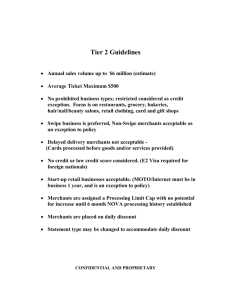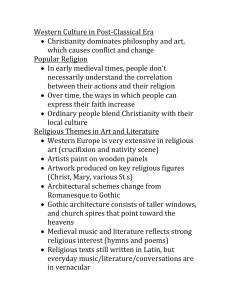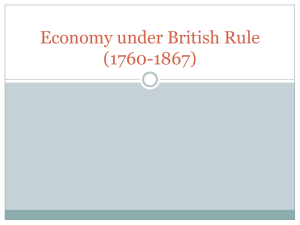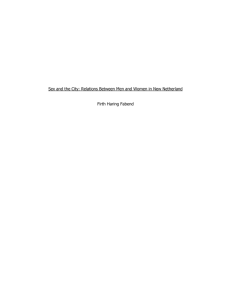New Netherland
advertisement
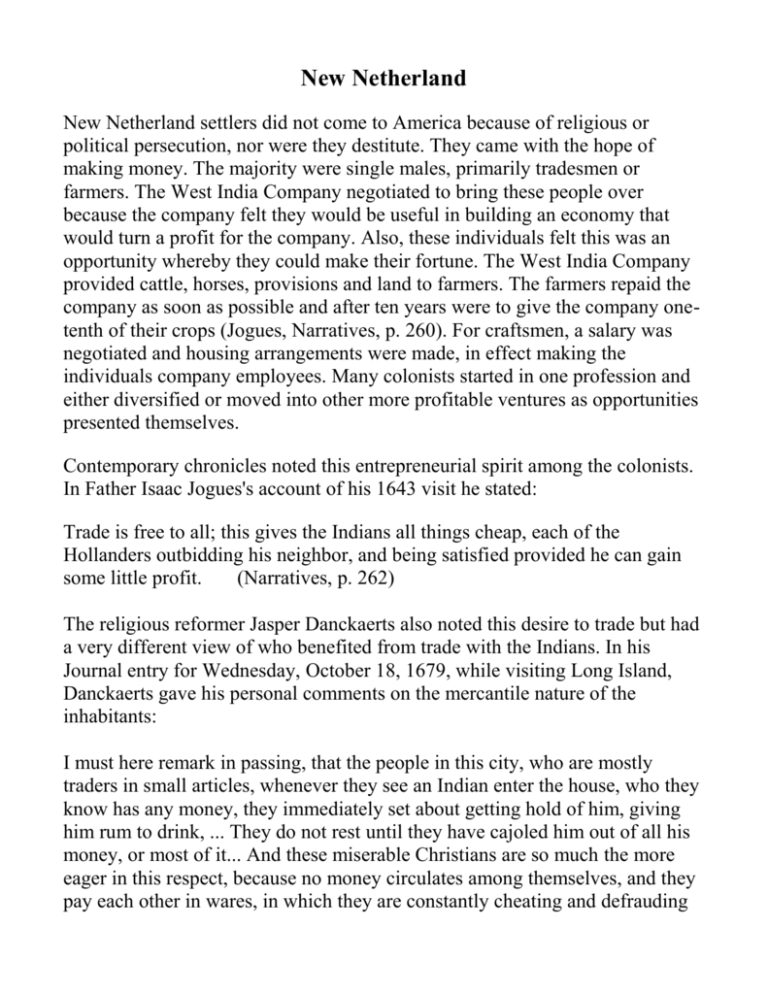
New Netherland New Netherland settlers did not come to America because of religious or political persecution, nor were they destitute. They came with the hope of making money. The majority were single males, primarily tradesmen or farmers. The West India Company negotiated to bring these people over because the company felt they would be useful in building an economy that would turn a profit for the company. Also, these individuals felt this was an opportunity whereby they could make their fortune. The West India Company provided cattle, horses, provisions and land to farmers. The farmers repaid the company as soon as possible and after ten years were to give the company onetenth of their crops (Jogues, Narratives, p. 260). For craftsmen, a salary was negotiated and housing arrangements were made, in effect making the individuals company employees. Many colonists started in one profession and either diversified or moved into other more profitable ventures as opportunities presented themselves. Contemporary chronicles noted this entrepreneurial spirit among the colonists. In Father Isaac Jogues's account of his 1643 visit he stated: Trade is free to all; this gives the Indians all things cheap, each of the Hollanders outbidding his neighbor, and being satisfied provided he can gain some little profit. (Narratives, p. 262) The religious reformer Jasper Danckaerts also noted this desire to trade but had a very different view of who benefited from trade with the Indians. In his Journal entry for Wednesday, October 18, 1679, while visiting Long Island, Danckaerts gave his personal comments on the mercantile nature of the inhabitants: I must here remark in passing, that the people in this city, who are mostly traders in small articles, whenever they see an Indian enter the house, who they know has any money, they immediately set about getting hold of him, giving him rum to drink, ... They do not rest until they have cajoled him out of all his money, or most of it... And these miserable Christians are so much the more eager in this respect, because no money circulates among themselves, and they pay each other in wares, in which they are constantly cheating and defrauding each other. (Danckaerts, Journal, p. 262) Indeed the mercantile nature of the people even extended to cases where the ministers sent from Holland to care for the spiritual needs of the settlers took their congregations to court because the parishioners were not forthcoming with the minister's contracted salary (an example from Brooklyn in 1657 is detailed in the commodity section and another example from Albany in 1683 is discussed in the beaver section). In order to tap this resource of entrepreneurship and thereby increase the revenue from the New Netherland settlement, in 1638 the West India Company abandoned its trading monopoly. The company felt it could share the expenses and risks associated with trade by opening up the area to other merchants and collecting fees from them. With the passage of the Articles and Conditions in 1638 and the Freedoms and Exemptions in 1640 the company allowed merchants of all friendly nations to trade in the area, subject to a 10% import duty, a 15% export duty and the restriction that all merchants had to hire West India Company ships to carry their merchandise. Of course the West India Company continued in the fur trade. A significant difference between these New Netherland merchants and the merchants in the British colonies, such as the Hancocks of Boston, was that the New Netherland merchants primarily worked at the local level and never controlled the foreign trade. They did trade on their own when it was possible but more frequently they were employed as agents or suppliers for the major Dutch trading firms. Oliver Rink has identified four firms that controlled more than 50% of the New Netherland to Holland trade during the period from 1640 throughout the Dutch era. These four firms were the merchant houses of Kiliaen van Rensselaer, Gilles and Seth Verbrugge, Dirck and Abel de Wolff and Gillis van Hoornbeeck. These four companies worked together to control most of the profits from the New Netherland trade. In the more prosperous years when there was no threat of war, other Dutch merchants, such as Gabry and Company, entered the market, but none kept up the sustained business of these four firms.
